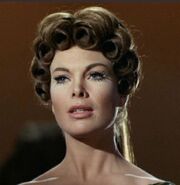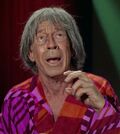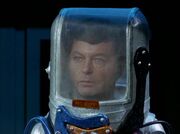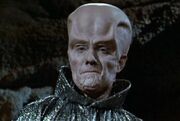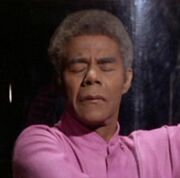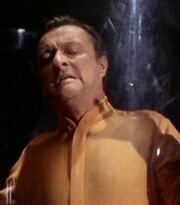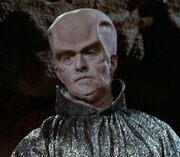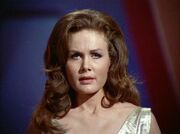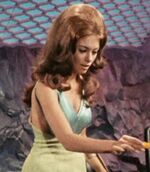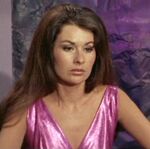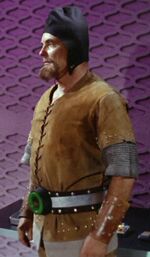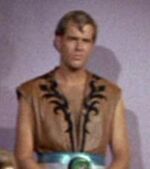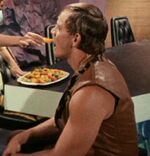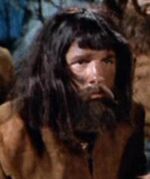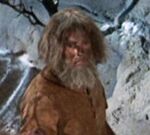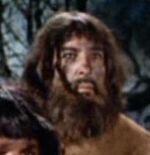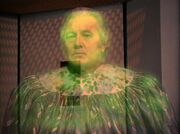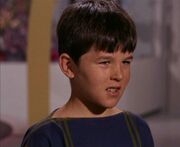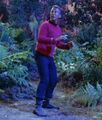This one’s okay; after the last few it’s a relief. Yes, there’s yet another all-powerful light blob, but it isn’t superior and there are a lot of Klingons around. They’re fun, and Kirk and his Klingon opposite number develop something like some kind of relationship. Seeing a Klingon woman is interesting, and she’s science officer, which is presented in an offhand way—back then both the fact and being offhand about it would count as a bit of a twist, I think. And at least there’s no big meteor headed for everyone, or a space fever that’s going to kill everyone, and no one finds the woman who will be the single great love of his life until the next episode.
The light blob does pop up a lot, though. It’s not enough the blob gets the Klingons on board the Enterprise and starts messing with people’s minds. It also has to turn all the phasers into swords, then give the Klingons a leg-up of some kind (which I forget). If you’re doing a script, it’s nice to have an all-powerful light blob around, but the tradeoff is that your story gets a bit weightless.
Klingons. I was dissing the old Trek version of the Klingons, but there’s something I should acknowledge: the Klingon uniform is a nice design. I like the black and gray, the white sashes and their fringe, which looks like an inch long. True, the sashes look like a plastic tablecloth that got cut up, and the jerseys and leggings and ponchos and so on look like they came out of the bottom of a theater trunk. But that’s execution, not design. The makeup and beards and outfits add up to a suggestion of what one would like to see on the screen; they’re stand-ins. (Did Abrams have Klingons in his Trek movie? My hope is that he’s doing old-style Klingons on a bigger budget. It would be nice to see the sleek, black-and-gray, 60s version done without period handicaps.)
Still, the Klingon ship is far superior to the rest of the gear, as execution and design. Maybe the ship needs a little retrospective help, a little translation from its period version, but not a whole lot. The models look a bit simple, but like the Enterprise and the bridge (also a little simple, in their ways) they work.
Also, I’m amazed anyone back then could have thought up those three designs, Enterprise, Bridge and Klingon vessel. With 40-plus years of Trek now gone by,the three designs still strike me as the most original the franchise has done. Whereas the ’60s Klingons’ makeup and gear strike me as being more in line with what primetime tv offered back then—my impression from childhood memories and from watching Mission: Impossible and Man from UNCLE now and then over the past few years.
From Mem Alpha, random script and production notes:
a line by Koloth in “The Trouble with Tribbles” suggests that females (“non-essentials”, as Koloth put it) don’t serve on Klingon vessels.
Although intra-ship beaming is routine in later incarnations of ‘Star Trek’, this is the first and only time it is done in the original series.”
This is the only time Sulu is seen in engineering or working in a Jefferies tube. … There is also a room or area called “emergency manual control” which seems to be the famous “Jefferies tube”, because Kirk orders Sulu to go down there and we next see Sulu standing in it fiddling with switches.
The Klingon agonizer used on Chekov is the same one seen in “Mirror, Mirror“.
Footage of the Klingon ship is reused from “Elaan of Troyius” which aired after this
The footage of engineering, with the hovering entity, was also re-used in “The Tholian Web“, with a floating Kirk instead.
Jerome Bixby’s original draft had the Klingons and Enterprise crew driving the entity away by singing songs and having a peace march.
According to Emerson Bixby, son of Jerome Bixby, James Doohan was taken aside before filming his dramatic scene on the bridge. Much to Doohan’s delight, Bixby asked him to pronounce the word “Vulcan” to sound euphonically like a certain expletive. Listen closely to Scotty’s stern insistence that Spock keep his hands off of him.
The Klingon, b. 1922, Syria. Married to Barbara Eden when “Dove” was filmed. Wiki says, “Ansara guest-starred on Eden’s I Dream of Jeannie series, as the Blue Djinn, who had imprisoned Jeannie in a bottle, and as King Kamehameha in the episode “The Battle of Waikiki”. The couple had one son together, actor Matthew Ansara, who died on June 25, 2001, of a heroin overdose. Michael Ansara and Barbara Eden divorced in 1974.”
Mem Alp: “After co-starring together on Star Trek‘s ‘Day of the Dove,’ Ansara and Susan Howard (who played Kang’s wife, Mara) reunited for an episode of Here Comes the Brides in 1969…” And Mark Lenard was a Brides regular.
Ansara was very busy with tv in mid-’60s. Also, yet another Presley credit for a Trek guest: Prince Dragna in Harum Scarum (1965). IMDB lists 189 roles for career, starts with Battle in Arabia (uncredited, 1944), ends with voice role in cartoon movie (Batman: Vengeance, 2001). A lot of desert-people roles: ’50s movies: uncredited in The Robe (no, Judas, per Wiki) and Ten Commandments; did 3 movies w/ Montalban, inc Saracen Blade; in Greatest Story Ever Told as “Taskmaster,” working for Herod. 1977, Mohammad: Messenger of God, played Abu Sufyan, who opposed Mohammad and then converted.
Career overview: During the ’50s a lot of Biblical Jews and American Indians, during the ’60s still the Indians but also other roles. Worked steadily with tv guest shots thru the ’80s, crime shows mainly, then in the ’90s it’s pretty much Trek/Babylon 5 stuff and cartoon voice work, with an emphasis on Mr. Freeze in the Batman series.
Klingon gal. b. 1943 or 1944, in Marshall, Tex. Wiki says, “an active member of the leadership of both the NRA and the Texas Republican Party.” Real name: Jeri Lynn Mooney; stage name: Susan Howard.
While in high school she won a statewide scholastic award as best actress. She was a Dallas reg, 189 eps as Donna Culver Krebbs. Wiki: “In 1987 the show decided to not renew her contract. She has blamed this decision on her opposition to what she saw as pro-abortion storylines involving her character.”
Per IMDB, “Dove” was her eighth screen job on a list of 50, and she started in 1967 with a Monkees ep (role: “The Bride”). Whitebread-sounding character names, shows like The Iron Horse, Flying Nun, Tarzan. Lot of roles post-Trek, in 1969 (Ironsides, Bonanza, I Dream of Jeannie, Land of the Giants, others), then down to 3 or so per year in 70 and 71, then picks up the pace in ’72 and continues pretty healthily after that until her Dallas niche. (Note: Mem Alp says she started in 1966.) Post-Dallas, one role listed, appears to be the lead in an indy drama released 1993.
Redshirt with changed name. Played by David L. Ross, b. 1939
Galloway in 5 first-season eps and two second-season eps (and in photo above), Johnson in this one, and then he’s Galloway again in “Turnabout Intruder,” the third season’s last ep. In “Dove,” as Johnson, the actor gets a big scene for a redshirt, if I remember right—he really wants to tear into one of those Klingons and he gets obnoxious with Kirk about it. Also, the character gets wounded early on and we see him in sickbay, not talking but he’s the shot.
Actor started as “Wounded Soldier” in a Combat! ep (1966), then “Delivery Man” in a Man from UNCLE (1967). Then the Trek stuff and then nothing until Rocky II and “Reporter,” which is in 1979.
Two lines, something lke that. Mark Tobin, no birth year. He was in “Space Seed” as a Khan follower, and here he’s the number-two Klingon guy. He gets to say something or other and pops up in a couple of the scenes aside from the grand melees where everybody was on board.
IMDB lists about 10 roles. He did a McHale’s Navy, three Combats, the Star Trek, and that’s about it. Started in 1960 w/ a Tombstone Territory, then was in something called The Man from the Diners Club (1963). Next the McHale’s in 1966, which was also the years of the Combats. So his years of working in tv were pretty much 1966 to ’68, and Trek was his last acting job until he hosted American Outdoorsman in 1995. Plus a Voyager (as “Klingon”) in 1999.
The immortal. “Crown prince of daredevils,” Wiki says, with 5,000 jobs in 60 years. David L. Sharpe, b. 1910 in St. Louis. IMDB lists 162 acting creds and 227 stunt creds: first acting job was in Scaramouche (1923), last was “Man in Suit” for Blazing Saddles (1974); fourth stunt job was in Thief of Baghdad (1924), last was in Warren Beatty’s Heaven Can Wait (1978).
Wiki: “Sharpe won the US National Tumbling Championship in 1925 and 1926. He began his film career as a child actor in the 1920s. Eventually he became the ‘Ramrod’ (Stunt co-ordinator) for Republic Pictures from 1939 until mid-1942,” then came WWII. … Died of Lou Gehrig’s disease, 1995.








